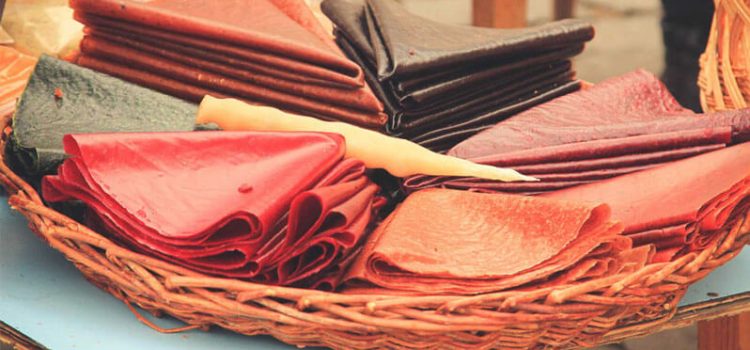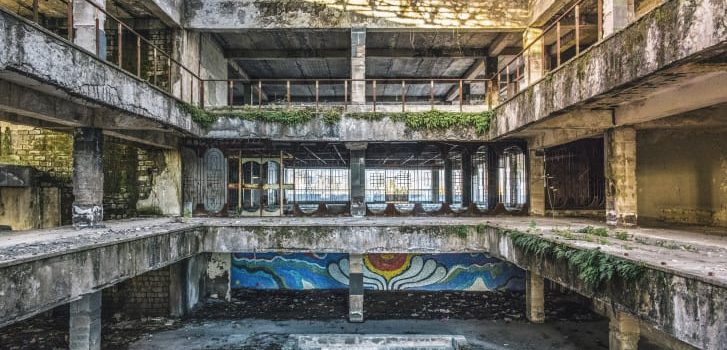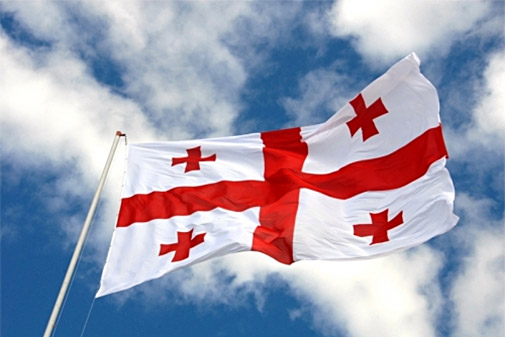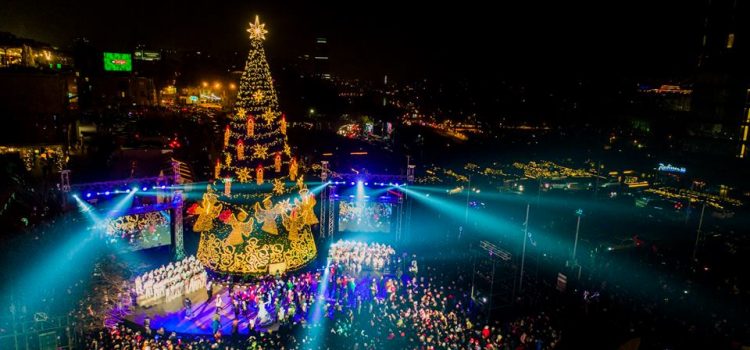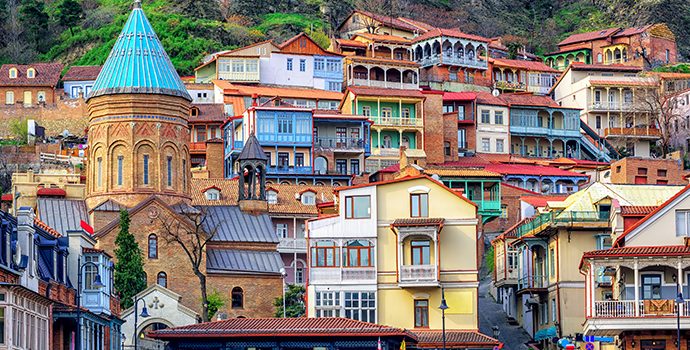Georgian desserts to taste in winter
Georgia offers a whole range of local dishes. Georgian cuisine has been shaped by different cultures such as ancient Greek and Roman, middle eastern Turkish, central Asian, Mongolian, Russian and Indian influences.
If you plan to spend winter in Georgia, you are recommended to taste top Georgian desserts. You will not be able to find the same taste elsewhere in the world.
Pelamushi is a Georgian dessert made with pressed and condensed grape juice, sugar, and flour. The liquid is gradually
heated until it thickens, and it is then poured into serving dishes, bowls, or various molds, in order to create attractive shapes. When fully chilled, pelamushi is ready to be served, and it is recommended to garnish it with various nuts and seeds.
Churchkhela is a traditional Georgian candy that is shaped into a sausage. It originated from the Caucasus region. This candy is made by dipping a long string of nuts (usually walnut halves) in concentrated grape juice, then leaving the concoction to dry. It is quite healthy and so nutritious that it was even carried by Georgian warriors on their long journeys in the past. Although walnuts are mostly used in the preparation of churchkhela, they can be replaced by almonds, hazelnuts, or raisins.
Tklapi is a unique Georgian dessert consisting of cooked fruit puree that is poured on a tray in a very thin layer and left to dry in the sun for a few days. It is typically prepared with fruits such as wild plums, pears, mulberry, figs, or apples. Visually, this healthy treat looks like a piece of leather. Tklapi can be consumed on its own or used in soups and stews.
Gozinaki is a traditional Georgian dessert with a crunchy texture, made with honey-fried, caramelized nuts such as walnuts, almonds, and hazelnuts. This sweet treat is often cut into diamond shapes, and it is traditionally consumed at Christmas and New Year.
Source: Georgianjournal.ge
The Guardian: Khinkali best eaten with alcohol
The Guardian published an article about the traditional Georgian dish Khinkali in 2017. The article reads about its history, art of consuming the dish and its types as well.
Georgians were ruled by Greeks, Romans, Iranians, Arabs, Byzantians, Mongolians, Ottomans, and Russians over the years. All of them brought their cuisine and ingredients into Georgia. Georgia managed to incorporate all the new ingredients and meals to create an identity for Georgian cuisine. When you eat Georgian food, you do not think it is Mongolian or Chinese but Georgian. Khinkali is believed to be brought by Mongolian warriors in the 13th century.
The dish is similar to the Taiwanese soup dumpling, xiaolongbao. The Georgian dumplings are filled with meat and spices (mushrooms, potatoes, cheese can be used instead of meat), then traditionally twisted into a knot at the top. Regional differences influence the fillings and every part of Georgia has their distinctive variety. For example, in the mountainous regions, the most traditional filling is lamb. The most frequent variety (often served in Georgian restaurants) throughout entire Georgia is a mixture of pork and beef.
Khinkali are traditionally the food of shepherds in the Tusheti and Pshavi regions mountainous regions of northern Georgia.
“Locals are skilled in the art of extracting the hot juices in one bite, cautiously using the top knot of dough as a handy grip. Plates strewn with discarded knots sit on cafe tables.”
The founder of Kartveli Tours (tours in Georgia) Irakli Shengelia says to the Guardian that both beer and vodka goes well with the dish. He explains the Georgian term Chakiduli meaning “a shot of vodka followed by a beer”.
Source: Georgianjournal.ge
CNN about abandoned Tskaltubo Spa
CNN has recently published an article about the abandoned sanatoriums of Tskaltubo, a town in the west part of Georgia. The article states that throughout the Soviet era, the USSR built 186 sanatoriums across the state. Tskaltubo spa is considered to be one of the best sanatoriums.
The natural springs emanate from limestone massifs deep beneath the ground, releasing radon-carbonated and mineral-enriched water. According to the European Historic Thermal Towns Association, the spa was regarded as “waters of immortality” dating back to 7th century. The springs are believed to have healing properties.
After the fall of the Soviet Union, the sanatorium lost its function, vines, bushes, and weeds found their ways through the pillared hallways into the bathing rooms. Later in 1992, a bloody conflict broke out between government forces and separatists who fought for the independence of Abkhazia, a disputed autonomous republic in northwestern Georgia. After the fall of Sukhumi, the capital city of Abkhazia, thousands of Georgians were forced to flee the city. The refugees found the deserted corridors of the Tskaltubo sanatorium as a shelter.
The refugees have never left the place. The original settlers have had children, and now grandchildren. They had to adapt and create makeshift homes.
The design of the sanatoriums was a model of progressive Soviet architecture. The architecture was a fusion of what is now known as classical Stalinist design and ethnic Georgian decor, as well as Gothic and Roman features.
“They were frozen in time and objects were just sitting there, as if someone had just got up and left. It was as if the buildings were still used by the Soviet citizenship. But the objects had now become artifacts.” – said the photographer Ryan Koopmans. The article is accompanied by his photographs taken in Tskaltubo.
Leaving behind the bad times, the government has begun to re-home refugees and developers plan to relaunch the spa as a luxury tourist destination. Thus, these photographs of Tskaltubo sanatorium might soon be the last memory of the era.
Source: Georgianjournal.ge, Photo: Georgianjournal.ge
Top 10 Must-Try Georgian Dishes
Georgians were ruled by Greeks, Romans, Iranians, Arabs, Byzantians, Mongolians, Ottomans, and Russians over the years. All of them brought their cuisine and ingredients into Georgia. Georgia managed to incorporate all the new ingredients and meals to create an identity for Georgian cuisine. When you eat Georgian food, you do not think it is Mongolian or Chinese but Georgian.
Here are the top 10 dishes to taste in Georgia:
1. Khachapuri
khachapuri is the most famous dish in Georgia. The pastry is traditionally topped with melted cheese, eggs and butter. There are different types of khachapuri but it is usually filled with Georgian Sulguni or Imeretian cheese. Three of the most common varieties include the Imeretian khachapuri, shaped into a circular form, Adjarian khachapuri, the open-faced version topped with butter and a raw egg on top and Megrelian Khachapuri shaped into a circular form and topped with melted cheese.
2. Kuchmachi
Kuchmachi is a traditional Georgian dish made of pork/chicken hearts, livers, gizzards mixed with walnuts and pomegranate.
3. Shkmeruli
Shkmeruli (roast chicken in garlic sauce) is a very old Rachan dish and it is one of the most popular dishes in Georgian restaurants. It has to be noted that the name derives from one of the villages in Racha region of Georgia, Shkmeri, which is said to be the place where this food has originated.
4.Khinkali
Georgian dumplings known as khinkali are considered to be one of the national dishes of the country. The dumplings are filled with meat and spices (mushrooms, potatoes, cheese can be used instead of meat), then traditionally twisted into a knot at the top. Regional differences influence the fillings and every part of Georgia has their distinctive variety. For example, in the mountainous regions, the most traditional filling is lamb.
The most frequent variety (often served in Georgian restaurants) throughout entire Georgia is a mixture of pork and beef.
5.Ostri
Ostri is hot and spicy beef with tomato sauce. The meat should be very tender when fully cooked.
6. Kubdari
Kubdari is a bread filled with beef, pork, or a combination of the two flavored with spices such as cumin, dill, coriander, blue fenugreek, red pepper, onions, garlic, and salt. The dough consists of flour, water, yeast, sugar, salt, and eggs. Interestingly, the meat used in this savory pie should be cut, not minced. Kubdari originates from Svaneti, one of the most beautiful mountainous and winter resorts in Georgia.
7. Chikhirtma
Chikhirtma is a famous Georgian soap. It is often believed that the soap is the best hangover cure. It consists of chicken pieces, onions, eggs, flour, vinegar, water, and seasonings such as salt, bay leaves, and coriander. It has a slightly sour flavor and a thick, creamy consistency. The soup is usually served hot, and it is recommended to garnish it with freshly chopped coriander.
8. Satsivi
Satsivi is a thick nut paste. It usually includes garlic, coriander, cinnamon, vinegar, and hot peppers. Satsivi is typically served as an accompaniment to meat dishes. However, it can also be served with vegetable dishes, alongside fish, or even with boiled eggs.
9. Elarji
Elarji is a specialty of the Georgian Samegrelo region (western Georgia), prepared as a thick porridge consisting of coarse cornmeal, cornflour, and sulguni cheese. The dish has an extremely thick texture, and it is very elastic. It is traditionally served hot and consumed with Georgian bazhe sauce, made with garlic, walnuts, and various spices.
10. Pkhali
Pkhali is a traditional Georgian dish of chopped and minced vegetables, made of cabbage, eggplant, spinach, beans, beets and combined with ground walnuts, vinegar, onions, garlic, and herbs.
Source: Georgianjournal.ge
Photo: Georgianjournal.ge
Wine on Mars? The World’s Oldest Wine-Making Country Wants to Make It Happen
The first human colonists on Mars will have to forgo many of the creature comforts of Earth — things like enjoying an ozone layer, for example, or opting out of rearing genetically engineered Martian babies. Fortunately, one essential earthly amenity these hardscrabble colonists may not have to give up is wine.
Georgia, a country with an 8,000-year-old viticulture tradition, is putting its top space and wine scientists to work figuring out how to grow grapes on Mars.
The project, named IX Millennium, ostensibly as a nod to Georgia’s ninth millennium making wine, will involve several phases of research into building an agricultural infrastructure on Mars. One critical step: identifying the grape varietals on Earth best equipped to withstand the harsh radiation, fearsome dust storms and severe temperature swings of the Red Planet. This research could help hydrate permanent settlements on Mars a soon as 2024 — the year when SpaceX founder Elon Musk intends to launch the first crewed mission there. (NASA hopes to follow in the 2030s.) [Mars InSight Photos: A Timeline to Landing on the Red Planet]
“If we’re going to live on Mars one day, Georgia needs to contribute,” Nikoloz Doborjginidze, founder of Georgia’s Space Research Agency and an adviser on the wine project, told The Washington Post. “Our ancestors brought wine to Earth, so we can do the same to Mars.” (The origins of wine are still debated, but Georgia holds a valid claim thanks to their recent discovery of an old wine-stained pot dated to 6000 B.C.)
The first wine on Mars
The new space wine project will kick off later this year with the installation of “vertical greenhouses” inside a hotel in the capital city of Tbilisi, according to Georgian news agency Agenda.ge. There, floor-to-ceiling pods of soil and seeds (including grapes, strawberries and arugula) will be left to grow under hydroponic lights with minimal human interference, simulating the possible conditions of a controlled agriculture pod on Mars.
In the meantime, Georgian wine experts are hard at work trying to figure out which grape varietals might best survive harsh Martian conditions. Over the next few years, researchers at Tbilisi’s Business Technology University plan to simulate a Martian environment in the laboratory, exposing soil samples to subzero conditions, high carbon monoxide levels and thin air meant to mimic the atmospheric pressure at “20,000 feet [6,000 meters] altitude on Earth,” The Washington Post reported.
These experiments likely will not bear fruit until at least 2022, but scientists already have a hunch that white wine will fare best on the Red Planet.
“Whites tend to be more resistant to viruses,” Levan Ujmajuridze, director of Georgia’s vineyard Laboratory, told The Washington Post. “So, I’d imagine they’ll do well against radiation, too. Their skin could reflect it.”
These experiments could well provide future Martians with grapevines — but the actual fermenting, bottling and aging would be up to them. Nobody knows exactly how fermenting grapes in microgravity will actually work yet, but NASA scientists think it’s possible.
The Georgia team’s boozy experiments aren’t the first foray into space agriculture. Astronauts aboard the International Space Station (ISS) have already begun growing salad crops in microgravity, while China’s recently deployed Chang’e-4 lander will attempt to grow potatoes and rockcress (a flowering plant similar to cabbage and mustard) on the moon.
The makers of Budweiser, meanwhile, have launched barley seeds into space three times in hopes of becoming “the first beer on Mars,” while a batch of Ardmore scotch whisky spent three years aboard the ISS from 2011 to 2014. That project showed Earthlings that even an old drop of the pure is apparently not immune to the ravages of microgravity; the scotch reportedly came home tasting of “antiseptic lozenges” and “rubbery smoke.”
Originally published on Live Science.
Source: www.Space.com
Georgia marks national flag day
The current national flag was officially introduced on 14 January 2004.
The flag was used by the Georgian patriotic movement following the country’s independence from the Soviet Union in 1991.
By the late 1990s, the design had become widely known as ‘the Georgian historical national flag’ as vexillologists had pointed out the red-on-white Jerusalem cross shown as the flag of Tbilisi in a 14th-century map by Domenico and Francesco Pizzigano, the 14th century Venetian cartographers.
A majority of Georgians, including the Georgian church, supported the restoration of the flag that took place in 2004.
The winning entry replaced an earlier, three-colour flag first adopted for the 1918-1921 First Democratic Republic of Georgia before it was restored in 1990, ahead of Georgia’s proclamation of independence from the Soviet Union.
Drawn by painter Iakob Nikoladze, the design was selected for the original Republic that became independent from Imperial Russia following the 1917 Russian Revolution.
The State Council of Heraldry called upon Georgian citizens today to set and raise the national flag on their home windows, balconies, fences, roofs and cars to honour Georgian statehood and independence, national and individual freedoms.
Georgian President Salome Zurabishvili hosted a special event at her residency today and stated that the Georgian flag “symbolises the independence of the country, its freedom and everything which is valuable for us”.
The day of the national flag was first marked in 2012.
Source: Agenda.ge
Tbilisi gets ready to celebrate Christmas and New Year
Winter illuminations for Christmas and New Year are finally installed in Tbilisi, the capital of Georgia. Tbilisi’s main Christmas Tree was officially lit up on the First Republic Square on the 22nd of December. The event was accompanied by Christmas songs and performances. The prime Minister Mamuka Bakhtadze and the Tbilisi Mayor Kakha Kaladze participated in the event and wished the gathered people Happy Christmas and New Year.
Festive decorations were put on Rustaveli, Tamarashvili and Cholokashvili Avenues as well as Kostava,Baratashvili and Melikishvili Streets, which has made night strolls in Tbilisi even more enjoyable.
Top 10 Winter Experiences Of Georgia
We, Georgians, are the most welcoming people in the world! And we know how confusing it can be for you to plan your winter vacation in our country that has always been famous for its sea, sun, wine and mountains. That’s why we picked these ten experiences for you, so that you would make the most out of your holidays.
1. Learning to ski (if you still couldn’t)
There are really good ski instructors and ski camps for adults and kids at our ski resorts. The biggest amount of them is in Gudauri and Bakuriani.
2. Trying heli-ski (if you tried everything possible before)
If you are experienced enough, and your seek for adrenaline, heli-ski is something you would really enjoy! Untouched snow, fabulous altitude and crazy landscapes are waiting for you in Gudauri, Kazbegi and Mestia.
3. Visiting sulfur baths in Tbilisi
Everyone has heard about them, but not everybody knows that it’s not your average touristic thing. We go there too, when we are tired and want to recover. Strong massage with immense amounts of soap and hot sulfuric water do their thing pretty well!
4. Raving in Bassiani
The most famous Georgian club is not a place where you can easily walk it, which makes it more appealing to the fans of high class electronic music. Only top DJs, only right people!
5. Treating yourself with healing waters
Book spa treatment in one of the hotels in Borjomi, Sairme or Likani, or simply jump into the natural steaming water in the Mineral Waters Park in the center of Borjomi. The pools are located in its very end.
6. Having a wine tour
Even if the harvest season (Rtveli) is over, the wineries are always happy to welcome the guests. Encounter with 8000-years-old tradition of winemaking and sample the most interesting Georgian wines, so rich on tannins, so flavourful, so unique!
7. Visiting mysterious caves
Not far from Kutaisi, there are two caves that are accessible for the travelers – Sataplia and Prometheus are the names. Both of them are very impressive! The first one preserves the fossilized footprints of the dinosaurs, the second one is a bit bigger and offers a boat trip along the underground river in the end. Be aware of the fact that both are closed on Mondays!
8. Tracing different civilizations and cultures
Georgia was always in the middle of regional events, that’s why many cultures have influenced us. Visit the cave town Uplistsikhe to see how humans made the whole town out of rock several thousands years ago. A visit to the archaeological sites Dmanisi and Samshvilde will showcase the life of ancient people, and Svetitskhoveli Cathedral, David Gareji cave monastery, Nekresi Monastery hidden in the forest on the mount will show you the different aspects of early Christianity in Georgia.
9. Enjoy subtropical nature
Going to the West gives you a refreshing experience of seeing green plants in winter. For example, Batumi Botanical Garden is simply fantastic!
10. Shop Georgian!
Clothes made by the Georgian designers as well as food and spices made in Georgia are always on the shopping list of a person who wants to bring home something special. We are sure that you will find the best and most interesting accessories, clothes and jewelry for you and your friends and family!
Source: Georgia.travel
Winter In Georgia: Skiing And Spa
Georgia is getting more prominence as a ski destination – first of all, due to its long season (snowfalls in the mountains in April are something normal for Gudauri and Svaneti) and affordable prices for ski passes. The other reason is that it is still quite exotic for those who used to go skiing in Alps, Tatra or Carpathians.
We want to bring our country closer to you, so here are our options for those who like to combine skiing and spa treatment.
BAKURIANI
Number one choice in this case will be Bakuriani. This resort is located in central Georgia, climate is mild, and the local waters make good impact on health. They are softly mineralized, contain potassium, calcium, sodium and magnesium. The springs are located in the townlet Tsagveri and Mitarbi area, and you will also find bottled still water branded as “Bakuriani” in every Georgian shop.
The ski resort itself is the oldest one in Georgia, which means that the infrastructure has existed here for around 50 years, and recently it is getting updated and expanded. The new hotels and apartments grow there every year.
The most convenient area to stay for skiers is around Didveli Ski Lift or Mitarbi Ski Lift – you will have the direct access to the skiing area, and in the evening going to the cozy center of the resort with local restaurants, bars, ski rink, park and little cinema won’t be a problem. Just get a number of taxi driver in advance or ask for it in your hotel.
Talking about on site spa facilities – Orbi Palace, Crystal Bakuriani and Hotel Mgzavrebi are those hotels who have them. Indoor swimming pool and saunas are something you will definitely need after an active day on the slopes!
BORJOMI
If you want a leisure break during your skiing vacation, consider Borjomi at least for a day or two. This mineral resort is one of the oldest in Georgia – the spring was discovered in 1841, and with the time a beautiful park grew around.
The most relaxing option is to stay in one of four spa hotels in the town – Borjomi Palace, Crowne Plaza, Golden Tulip or Rixos Borjomi. Swimming pool and saunas are usually included in the room rate. Besides it, each hotel provides a wide range of healing and relaxing procedures, massages and cosmetology services.
The more budget-friendly option is to stay in one of the guesthouses that are many, and spend hilarious 5 lari for the chance to bath in the thermal spring in the end of the Mineral Waters Park. The spring is clean, and there are changing rooms on site too. The entrance to the park is 2 lari.
A walk toward the spring might take 30-40 minutes, and you will truly enjoy it: fresh air, sound of river Borjomi streaming towards river Mtkvari through the park, and the pleasant contrast of air and water temperature!
GUDAURI
The biggest and the most popular among freeriders, this resort is located in only 2.5 hours drive from Tbilisi. Seven ski-lifts (3 three-chair, 2 four-chair, 1 six-chair, 1 gondola), total altitude difference of 1258 meters, pistes from blue to black, breathtaking panoramas – simply awesome for a weekend break or a longer holiday!
For the guests that want to get decent spa and relaxation time, there are several places that offer it: Marco Polo Gudauri, Hotel Club 2100, Gudauri Hut Hotel, Carpe Diem Hotel, GoodAura Hotel and Tsar Bani Resort. New Gudauri Aparthotel also has a spa part – you should request this service before booking an apartment or hotel room there!
Also, famous Rooms Hotel Kazbegi has swimming pool with great view and good choice of extra procedures. Kazbegi (Stepantsminda village) is located in 30-40 minute drive from Gudauri, so you might go for a day trip there.
The choice is yours, and we are sure that you will have a great time in Georgia!
Source: Georgia.travel
10 things to do in Tbilisi
What is it about Georgia lately? The country (not the US state) seems primed to be one of the hottest tourist destinations for 2017, as travellers are freshly obsessed with the fashion, the mountain trekking, the architecture, and the good eats. The best news for those travelling from the UK? Georgian Airways launched direct flights from Gatwick to Tbilisi over the weekend; next month, Wizz Air will start a route to Kutaisi from Luton. Want to see what all the fuss is about? Here are our top 10 tips for what to do in Tbilisi.
Browse Soviet relics
From 1921 to 1991 Georgia was part of the Soviet Union. This history is evident everywhere, but most in your face while walking through the Dry Bridge Flea Market near Dedaena Park. Locals who lived the bulk of their lives under Soviet rule spread blankets on the ground and lay out goods they’ve saved from the scrap heap. The range of items is boggling; it’s priceless antiques next to plumbing fixtures, next to tarnished military medals and handmade crafts. Be prepared to bargain, and to receive a history lesson with each purchase.
Learn the etiquette of “khinkali” dumplings
Georgian dumplings are plump, round pouches filled with minced meat, chopped onion and spices. Pinched closed, you then flip the dumpling over and gingerly bite into its skin, sucking out the hot soup inside before going in for whole bites. Don’t eat the pinched bit; it’s not always cooked through and is used for staff to later count how many were eaten. Khinkali are omnipresent on menus in Tbilisi, but head to Barbarestan on Aghmashenebeli Avenue to try them alongside other Georgian dishes, their recipes straight from Barbare Jorjadze, a 19th-century princess and renowned cook who is generally accepted to have been Georgia’s first feminist.
Strip down and suds up
The ancient district of Abanotubani in Tbilisi’s old quarter is home to several equally ancient sulphur bathhouses. Head underground through brick entrances to pay an attendant for towel and sandal rental, and your choice of communal shower (separate for male and female) or private room with soaking tubs. Add on an exfoliating scrub-down and soapy foam massage for a few pounds more, but be warned that complete nudity is the rule. At the simply named Bathhouse Number 5, exquisite mosaics decorate the domed rooms, making up for the faintly eggy smell of the sulphur water.
Party at Fabrika
An old sewing factory turned hostel sounds like a stereotypical hipster hangout, and that’s totally true in Tbilisi. Fabrika offers communal, hostel-style rooms from as low as £10 per person, and private ensuite rooms for two are from £38 per night, but guests should be warned that the party in the public areas often lasts well into the night. The lobby bar Cocktails and Dreams, the courtyard strung with fairy lights, and the co-working spaces and artisan shops that make up the complex draw locals as well as visitors; you’ll make friends fast here.
Take in some culture
Tbilisi is no backwater destination; the spectacular Zurab Tsereteli Museum of Modern Art plays host to a biannual Fashion Week, the stunning architecture of the modern Peace Bridge lights up the riverfront at night, and the oddity of the 2011-constructed “Leaning Tower of Tbilisi” (aka the Gabriadze Clock) provides plenty of opportunities for Instagramming.
Eat a cheese-stuffed bread boat
Better known as “Acharuli Khachapuri”, this traditional Georgian comfort food is a gluten-free traveller’s nightmare, but heaven to most. The boat-shaped flatbread arrives fresh from the wood oven to the table, its centre bubbling with melted cheese, a runny egg, and a generous pat of butter. Even a small order is enough for two people, especially with a side of khinkali.
Yes, Georgian wine is fabulous. Red or white, dry or sweet, it’s all extraordinarily drinkable thanks to the fertile environment of the lower Caucasus, one of the most ancient viticulture regions in the world. But branch out beyond the wine for chacha (ჭაჭა), which is no dance in Georgia. Chacha technically refers to any fruit-based liquor, but it’s come to be most synonymous with grape brandy, produced from the leftovers during winemaking. It’s clear and strong, and most similar to Italian grappa. Stop into the parlour-style Books Cafe on Tsinamdzghvrishvili Street (yes, Georgian street names are epic) for a thimble full of chacha, a game of backgammon, and a browse of their used books for sale.
For something a little less strong, hit up a Georgian soda fountain for “Lagidze waters,” cool and sparkling concoctions of flavoured syrup mixed with mineral water. Invented by pharmacist apprentice Mitrofan Lagidze in the late 1800s, the drinks are cheap, fast, and refreshing. The most popular varieties of lemon, grape, cherry, and even chocolate, are poured and mixed from traditional dispensers at places like Acharulebi Lagidzeze and the aptly named Lagidze Water at Sameba Cathedral. Point to the bright green syrup to try Tarkhun, or tarragon soda, a flavour embraced by the Soviets and now produced and available bottled in supermarkets as “Тархун.”
Get high
Tbilisi sits in a valley, cut through by the Mtkvari River and backed by small mountains. Heading up Mount Mtatsminda to reach a small amusement park and the best view over the city is easy via modern funicular. There’s also the option to visit the Narikala Fortress via cable car from Rike Park, which comes with the bonus of gliding right over the twisting streets of Tbilisi’s old quarter before arriving to the medieval ramparts of the fort.
Make a salad
According to Megan Starr, a travel blogger who regularly visits countries of the former USSR, Tbilisi is the perfect destination for salad lovers. If there’s one dish ideal for summer, it’s the simple and filling Georgian Salad. Quarters of ripe, juicy tomatoes fill a bowl with slices of onion, cucumber and green pepper. It’s finished with a palmful of walnuts, a dusting of pepper, and a drizzle of olive oil. Get it at Linville, a cosy and antique-filled first-floor cafe near Freedom Square, where the salad is terrifically refreshing on a humid day, and even better with a glass of crisp white Georgian wine.
Get out of town
Technically this list is what to do in Tbilisi and can be rushed into a long weekend. If you have more time, use the trip as a two-for-one, adding exploration of Kutaisi, Kazbegi or Batumi to your plans. Kutaisi is a pedestrian-friendly city of streets lined with gardens, theatres, and several medieval church and monastery UNESCO World Heritage sites. The frontier mountain town of Kazbegi, also called Stepantsminda, is for hikers and, in the winter, for skiers. The Georgia-based luxe hotel group Rooms Hotels recently opened a “retro-Soviet meets industrial chic” property in the town.
Source: Independent.co.uk

